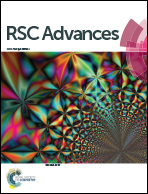Copper–Schiff base alumoxane: a new and reusable mesoporous nano catalyst for Suzuki–Miyaura and Stille C–C cross-coupling reactions
Abstract
Herein for the first time, a mesoporous copper nano catalyst (SBA–Cu2+) were simply synthesized through immobilization of Cu2+ on surface of Schiff base alumoxane support. This nano catalyst was characterized by various techniques such as FT-IR, X-ray map, TG-DTA, BET, SEM, SEM-EDS, TEM, ICP-OES and XRD. The characterization results indicated that SBA–Cu2+ nanoflakes with 331.47 m2 g−1 specific surface area are thermally stable up to 306 °C. The SBA–Cu2+ nano catalysts showed significant activity for Suzuki–Miyaura and Stille cross-coupling reactions with good efficiency and reusability. In addition, the nanocatalyst could be recovered and reused several times without significant loss of its catalytic activity. Copper leaching from SBA–Cu2+ is very negligible for this coupling reaction.



 Please wait while we load your content...
Please wait while we load your content...